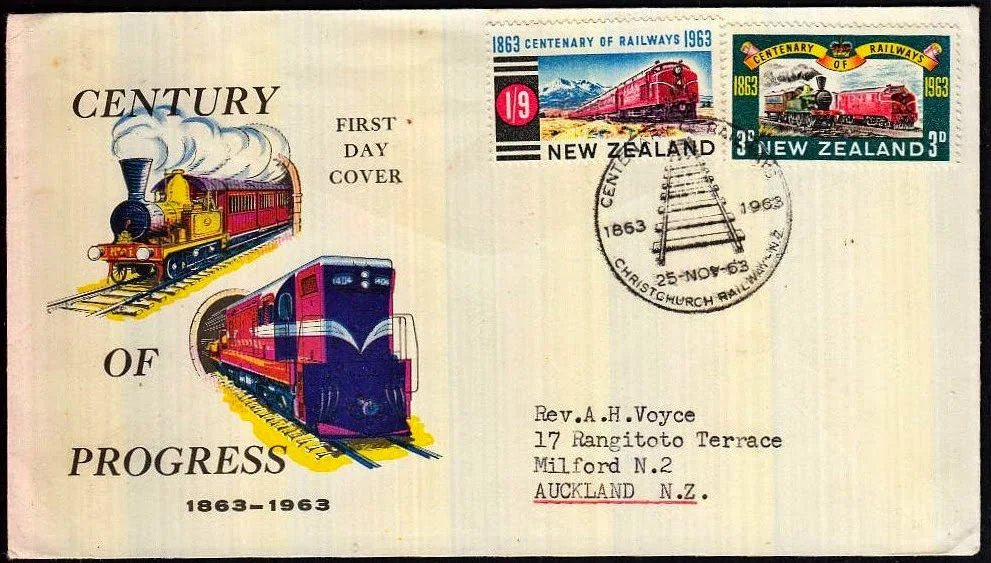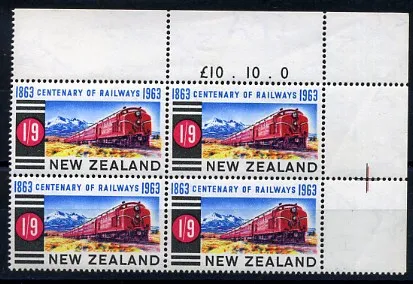For other stamps with a train theme see our collection Trains of New Zealand.
1963 Railway Century.
1963 Railway Century.
A two value issue to mark 100 years of railways in New Zealand. The first railway line in New Zealand ran from Christchurch to Ferrymead and was completed in 1863, the centenary of the event was commemorated by an issue of these two stamps.
The 10 Class DF (2-Co+Co-2) introduced in 1954 were New Zealand's first main-line diesel-electric locomotive. Built by English Electric of Great Britain the DFs and their half size sisters the DGs were soon superseded by the more robust USA build DA Class. Although depicted here hauling a Main Trunk express under the watchful Mount Ruapehu in the background, they spent most of their working life on less important routes such as the Bay of Plenty line.
This stamp featured the early steam locomotive 'Pilgrim' and a 69 ton 750 hp "DG" class A1A-A1A diesel-electric locomotive. Pilgrim hauled the first train on New Zealand's first steam operated railway between Christchurch and Ferrymead. The DG class was the small single cab sister to the more powerful DF Class depicted in the higher value of this issue.
I have never been a big fan of the DF & DG locomotives. I don't like their rounded look. Personally the DA seen on the First Day Cover below has a much more business like appearance. They have given NZR great service too. Where only a few examples of the DF & DG class can be found with preservation groups, many of the DA class are still working hard now rebuilt as the DC class.
Two First Day Covers for the same set.
A First Day Cover showing 'Pilgrim' from 1863 and a class DA locomotive of 1963.
Another First Day Cover showing as actual photograph of 'Pilgrim'.
Some Printing Flaws.
On the stamps above the blue sky has been effected. In the mint one (right) the blue is completely omitted while on the used one (left) hints of blue can be seen. Compare with the correct stamp and it is quite obvious. Notice the post mark on the used stamp, it is the town of Stoke, near Nelson, once an important station on the railway south from Nelson.
On this example of the higher value, the red has been omitted leaving this stamp looking very uncompleted.
Notice the sheet value on the top selvage of this block, this is a value block from the 1/9 stamp. What is of interest here is that it has also suffered a shift in the red. This can be seen around the edges of the locomotive but it stands out better in the colour control lines on the right hand side.
On the cover below the 1/9 stamp has suffered a perf shift so now the blue writing of the dates at the top is partly cut off while there is a very wide white margin at the bottom. The cover is of interest too being a railways NZR cover from Palmerston North, once a major junction on the Main Trunk Line.
1973 Steam Locomotives.
1973 saw the issue of another NZ train issue. This time the theme was New Zealand designed steam locomotives. The full set of four can be seen on the First Day Cover above. The locomotive featured on this cover is the "Ab" Class Locomotive from the 5c value.
This set can also be viewed on our post 1970s Vintage Transport Series.
On the cover below on the left can be seen a KA class locomotive. They and their sisters the smaller JA class were New Zealand designed and mostly built, the final development of steam in New Zealand. They were the main work-horse of the railways before being replaced by the DA diesel locomotives. (You can see a JA class on the 10c value.)
The Stamps.
"W" Class Tank Locomotive - 3c
The "W" Class tank locomotive was the first engine built by the New Zealand Railways Workshops in 1889. It was very useful for branch-line and suburban passenger work. The "W" Class was followed by other tank locomotives of similar but more modern design including the famous "Wab" Class.
"X" Class Locomotive - 4c
The "X" Class locomotives first built in 1908 were among the first four cylinder compound locomotives in the world. They were specially designed for heavy service over the steep grades of the North Island Main Trunk. Eventually all the X Class were retired, being replaced by the larger KA & JA classes. (See First Day Cover above).
"Ab" Class Locomotive - 5c
The "Ab" Class locomotive was for many years the Railways' maid of all work and between 1915 and 1926, 141 were built. To me this was a great looking engine. They could be found roaming all over the NZR rail system doing anything from mainline passenger work to branch line freights. No. 608 "Passchendale" the locomotive depicted on the stamp was one of two engines of this class to carry a memorial plaque.
"Ja" Class Locomotive - 10c
The "Ja" was the last steam locomotive to be built by the New Zealand Railways and No. 1274 was the last of 35 of this class built. The "Ja" was an upgraded version of the "J" class designed for mainline passenger and fast freight work.
Some Printing Flaws.
The two stamps above show a very wide variation in the red and black on the 5c stamp. I am unsure why both colours should be effected.
5c Class "Ab" with the red doubled (printed twice).
In the stamp above and the block of four below we can see the result of double printing. On the 3c stamp the red has been double printed while on the 4c block below the black was double printed. The stamps appear to be slightly blurred, result of double images.
Another example of double printing of the black is shown on the left with a normal example shown on the right. This error can best be seen in the words "Class X" in the bottom right corner but a close inspection of the locomotive will reveal a general blurring of the design.
Here are two very good examples of the problems the 4c value experienced during printing. I have been able to enlarge them here since they are such good images. Above the black can be clearly seen to have been printed twice. I have seen a number of these and even show a couple of examples of this above but this is the worst I have seen.
Below we see a white mirror image of the rails and wheels under the locomotive. It appears to be a colour shift in the red background colour.
Here is an interesting pair. In both values the perf has shifted so now "New Zealand" is very close to the bottom edge leaving a lot of blank space at the top. Below we can see the same error on a plate block from the 10c value. Interesting to have three values effected by the same problem like this.
Technical information - 1963 Railway Centenary.
Date of Issue:
|
25 November 1963
|
|---|---|
Designers:
|
New Zealand Railways, Wellington
|
Printers:
|
Thomas De La Rue, England
|
Stamp Size:
|
40mm x 24mm
|
Sheet Size:
|
120 stamps per sheet
|
Process:
|
Photogravure
|
| Perforation Gauge: |
14
|
Paper Type:
|
Multiple NZ and star watermark
|
Technical information - 1973 Locomotives.
Date of Issue:
|
4 April 1973
|
|---|---|
Designers:
|
R M Conly, Christchurch
|
Printers:
|
Harrison and Sons, England
|
Stamp Size:
|
42mm x 25mm
|
Sheet Size:
|
100 stamps per sheet
|
Process:
|
Lithography
|
| Perforation Gauge: |
14.25
|
Paper Type:
|
Chalk surfaced, unwatermarked
|
Some of the images in this post were used with permission from the illustrated catalogue of StampsNZ
You can visit their web site and On-line Catalogue at, http://stampsnz.com/
Information for this post came from.

























We appreciate your engagement with our content. To ensure a respectful and constructive community, please take note of the following:
- No Spam, Please: We do not tolerate spammy or promotional comments. Any such comments will be promptly removed.
- Moderation in Place: All comments are moderated to maintain a positive and inclusive environment. Please be patient, as it may take a little time for your comment to appear.
- Sign In with Google: To comment, please sign in using your Google account. This helps us maintain the integrity of our community and allows for better interaction.